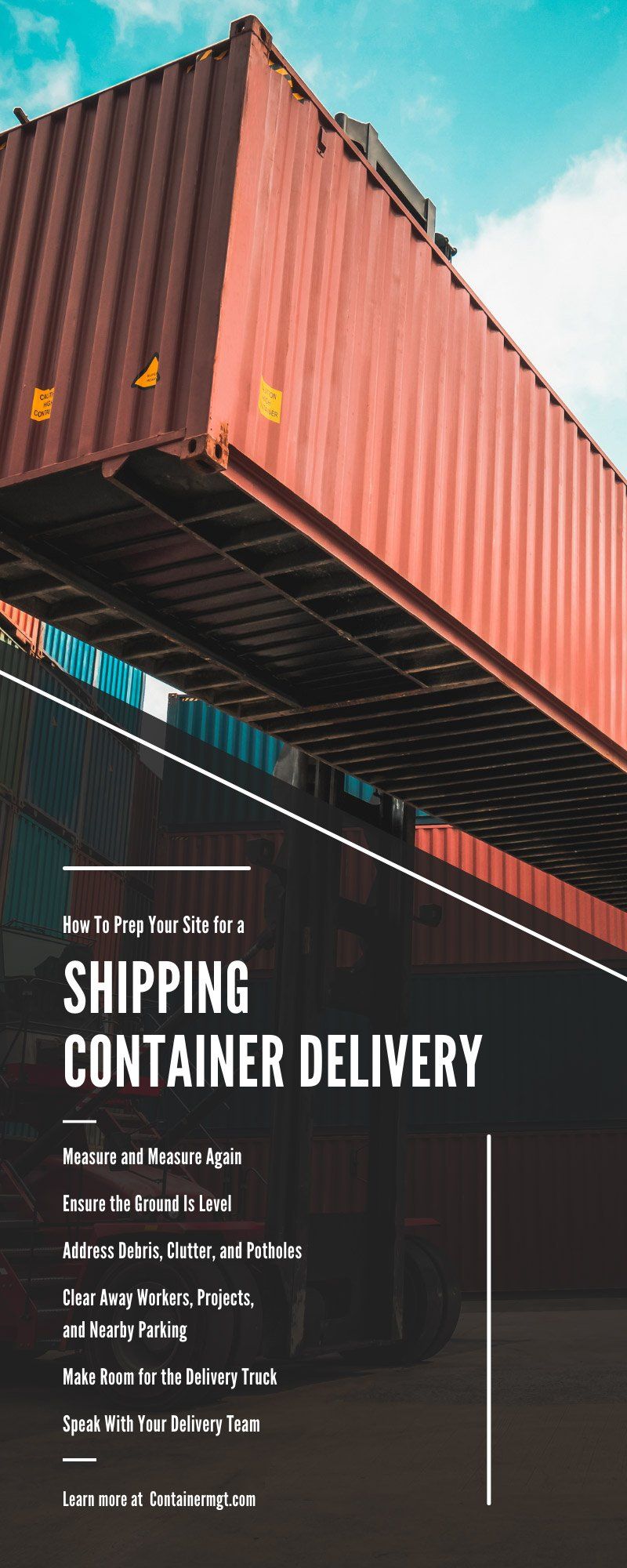How To Prep Your Site for a Shipping Container Delivery
Written by Susan Nalevac | January 05, 2022
As your shipping container company prepares your container for delivery, it’s critical that you do your part to make the delivery site accessible and safe. Proper site preparation ensures that neither you nor your delivery team must tackle any last-minute problems that could impact the plans you have in mind for your container. Let’s explore how to prep your site for a shipping container delivery to make the process more efficient for everyone involved.
Measure and Measure Again
The first step in preparing a site for a shipping container delivery is measuring. Moving a shipping container after it’s been delivered into a spot that isn’t as ideal as you first imagined complicates the process. You can avoid this delay by measuring the area multiple times to ensure you have space for either the single container or multiple containers. Communicate clearly with your shipping container company about the exact size of your containers beforehand. It’s also important to consider the area around the container and how your employees or guests navigate that space, should the shipping container act as a permanent addition.
As you measure, consider if you might ever bring additional shipping containers to the site. It is easier to prep the site for multiple containers all at once instead of going through the process each time you add one.
Ensure the Ground Is Level
Ensuring that the ground where your shipping container sits is level is among the most important steps as you prep your site for a shipping container delivery. Level ground ensures not only that your shipping container and its contents are safer from damage caused by uneven weight distribution, but that the delivery truck is also safe during the delivery. Uneven or uncompacted ground can lead a delivery truck, weighed down further by the weight of the container, to sink. This issue can cause massive delays for both your site and your driver.
You have multiple options when it comes to how you achieve and set up a properly leveled site. Some of these options include:
Leveling By Paving
If you have already paved your site, it is likely able to withstand the weight of the shipping container without issue. It’s still important to check that the site is level, as uneven ground can lead to issues opening and closing the shipping container doors. You can also create a new paved or concrete site specifically for the shipping container.
Leveling By Compacting
If you are instead having a shipping container delivered onto unpaved material like sand, gravel, or soil, it is crucial to compact the surface. A mechanical tamper can help you achieve the necessary level surface, but heavy equipment like a roller is crucial for correctly compacting the ground.
Keeping a Container Off the Ground
Some buyers choose to keep a container lifted off the ground, supported by blocks or beams. This decision makes it easier to pick up and move the container later while also limiting wildlife or pooled water’s access to the container. However, lifting the container also leads to potentially uneven weight distribution and further leads to sinkage. If you are considering propping up your shipping container, speak with your shipping container company about your needs and how to meet them without future issues.
Check for Suitable Sloping
You may choose the site for your shipping container based on its accessibility or position away from daily workflow, but it’s also important to pick a site that weather won’t impact. Placing a leveled site at or near the bottom of a slope can lead to water pooling at the base of your shipping container. Even for watertight containers, this can present an issue as the ground beneath may soften and cause sinkage. When inspecting a site, consider the work required to level the area as well as the slope of the ground and its surrounding environment.
Address Debris, Clutter, and Potholes
After you’ve finished leveling the site area where you want the shipping container to go, it’s essential to keep a continuous eye out for any debris, clutter, or potholes that could negatively impact the delivery. Active sites often change day by day, so it’s wise to do a site check each day and address any debris as it appears. Along with clutter on the ground, you should also remain conscious of the height of cables or tree branches that could limit the delivery truck’s mobility.
Clear Away Workers, Projects, and Nearby Parking
Debris and clutter serve as obstructions that can impact the leveling of your intended surface and make the delivery process more complicated. However, another significant issue often present on delivery sites is the workflow happening around the delivery site itself. Where employees park, where they are actively working, and the projects they’re working on can present issues.
It’s important to consider the entire path of the delivery truck and the surrounding area. If able, relocate parking spaces or projects in the area to avoid any potential problems and allow your delivery driver to navigate with fewer surrounding objects to worry about.
Make Room for the Delivery Truck
While removing debris and reorganizing parking to make room for the container is important, it’s also necessary to clear a path for the delivery truck itself. Active construction sites should ensure their entry gates can open entirely to make room for the truck when it arrives. It’s also important to maintain a clear path for the driver to pull in or back into the site as needed. Creating these paths days prior to the delivery is ideal.
Speak With Your Delivery Team
The most important aspect of delivery preparation is communication with your delivery team. If anything about your delivery situation or site accessibility changes, it’s critical to communicate these changes to your delivery team as early as possible to avoid confusion. Your delivery team can also answer any questions you have regarding how you can help them do their job as efficiently as possible. Whoever you provide as a point of contact for your shipping container company should remain onsite the day of delivery to help your driver and prevent any delays.
Shipping containers are a versatile tool for many businesses, functioning as portable storage units and annexed offices alike. If you’re seeking shipping containers for sale in Chicago, our team at Container Management is happy to work with you. Our local location carries new and used 20-foot and 40-foot container options, as well as a fabrication center to make your modification ideas a reality. Reach out to our knowledgeable team of experts with any questions and request a free quote today!The body content of your post goes here. To edit this text, click on it and delete this default text and start typing your own or paste your own from a different source.






